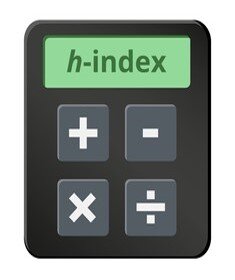Find your h-index in Google scholar


The productivity and impact of a researcher's articles are both represented numerically by the h-index. It is calculated by counting the citations an author's articles obtained. When an author's h-index is "h," it means that they have authored "h" publications that have each received "h" or more citations.

Advantages of Using Google Scholar for h-index Calculation
Broad Coverage
The extensive collection of Google Scholar contains academic publications from journals, conferences, theses, and dissertations. It covers a wide range of disciplines, making it suitable for researchers in diverse.
Free Access
Unlike subscription-based databases, Google Scholar is freely accessible to anyone with an internet connection. This accessibility makes it a popular choice for researchers worldwide, especially those who do not have access to expensive subscription databases.
Ease of Use
Google Scholar's user-friendly interface and search capabilities make it easy to find relevant publications and track citation counts. Researchers can quickly retrieve citation data for their articles and calculate their h-index without needing complex queries or specialized knowledge.
Inclusion of Non-Peer-Reviewed Sources
Google Scholar's indexing includes diverse sources, including preprints, conference papers, and institutional repositories. While this broad coverage can be advantageous, it also means that non-peer-reviewed sources can contribute to citation counts. Researchers should exercise caution when interpreting h-index values derived solely from Google Scholar.
Inconsistencies in Citation Counts
Google Scholar's citation counts can vary significantly from other databases. The presence of self-citations, variations in indexing algorithms, and data sources all contribute to this disparity. Researchers should be aware of these inconsistencies and consider cross-validating their h-index using multiple databases.
Lack of Transparency
Google Scholar does not provide detailed information about its indexing methods or the sources it includes. It may be laborious to evaluate the precision and reliability of citation data due to this lack of transparency. Researchers should be cautious when using Google Scholar as the sole source for h-index calculations, particularly for formal evaluations or comparisons.
Disciplinary Variation
The h-index can vary across different disciplines due to variations in publication practices, citation patterns, and the size of the research community. Researchers should consider comparing their h-index to others in the same field to comprehend their impact.
Self-Citation Awareness
Google Scholar includes self-citations in its citation counts. While self-citations can be valid and necessary in some cases, researchers should be mindful of excessive self-citation practices that can artificially inflate their h-index.
Data Updates
Google Scholar constantly updates its database, incorporating new publications and citations. Researchers should regularly check and update their h-index to reflect the most recent available data.
Google Scholar provides a free and accessible platform for researchers to calculate their h-index. Its broad coverage and ease of use make it a convenient tool for estimating citation counts and evaluating research impact. However, researchers should be aware of its limitations, such as the inclusion of non-peer-reviewed sources and potential inconsistencies in citation counts. Cross-validation with other databases and considering disciplinary variations are essential when using Google Scholar as a metric for h-index calculations. By understanding the advantages and limitations of Google Scholar, researchers can effectively utilize this resource to assess their research impact and contribute to their respective fields.
SITA Academy
SITA Academy is your trusted partner in achieving a high h-index through successful journal article publication. Our team of experienced researchers and publication experts understands the significance of a strong h-index in showcasing the impact of your research.
We provide comprehensive support to researchers, offering services such as manuscript editing, strategic journal selection, and guidance on maximizing citation potential. With our expertise, we help researchers navigate the complex publication process, ensuring that their articles are published in reputable journals that contribute significantly to their h-index.
Trust SITA Academy to elevate the visibility and impact of your research, ultimately helping you achieve a high h-index and recognition in your field.
Contact us today to learn more about how we can assist you in reaching your publication and h-index goals.

If you have any questions, inquiries, or would like to learn more about our services, please don't hesitate to reach out to us. Our dedicated team is ready to assist you.